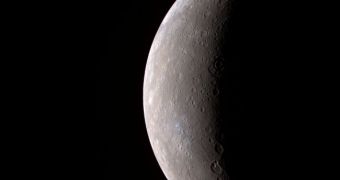NASA scientists were able to insert the first spacecraft ever into orbit around Mercury, after the probe spent more than 6 years traveling through the inner solar system. MESSENGER achieved the critical mission milestone on Thursday, March 17.
During the maneuver, the vehicle had to slow its speed down by about 1,900 miles per hours (3,058 kilometers per hour). In order to achieve this, it had to fire its main thruster for about 15 minutes.
In order for a spacecraft to achieve orbital insertion, it needs to allow itself to get captured by its target planet's gravitational pull to exactly the right extent. Any miscalculation could see it either go past the planet, or crash into its surface.
The maneuver MESSENGER had to carry out was not without risk, especially considering the age of the probe. During its travels (which covered some 4.9 billion miles, or 7.9 billion kilometers thus far), it carried out numerous flybys.
It did one of Earth shortly after launch, and two around Venus later on. The following three were flybys of Mercury, as the spacecraft was being set on the correct path to achieve a March 17, 2011 insertion.
NASA mission controllers began the maneuver at 8:54 pm EDT (0054 GMT), and received confirmation of its success about an hour later. The spacecraft is now happily buzzing around Mercury in a 12-hour orbit.
At the Johns Hopkins University' (JHU) Applied Physics Laboratory (APL), where the MESSENGER mission control is based, applauses and congratulations resounded throughout once news of the maneuver's success started making the rounds, Space reports.
“This is when the real mission begins. It's just all coming together and we are really ready to learn about one of Earth's nearest neighbors for the first time,” Sean Solomon said last night.
The expert, who is based at the Carnegie Institution of Washington (CIW), is the principal investigator of the MESSENGER mission. ”The mood is fantastic,” added Ed Weiler, the science missions chief at the American space agency.
“It only happens once in human history, and it's just beginning. We're going to learn a lot more about Mercury than we've ever seen,” the official added, referring to the innovative orbiter mission.
Mercury never had an artificial satellite before, or any type of satellite for that matter, yet it does have numerous mysteries, that researchers want to get to the bottom of. MESSENGER will provide a helping hand in this regard.
“The spacecraft is ready, and the team is ready. On April 4, we'll begin prime science,” explains APL expert Andy Calloway, who is the spacecraft's mission operations manager.

 14 DAY TRIAL //
14 DAY TRIAL //